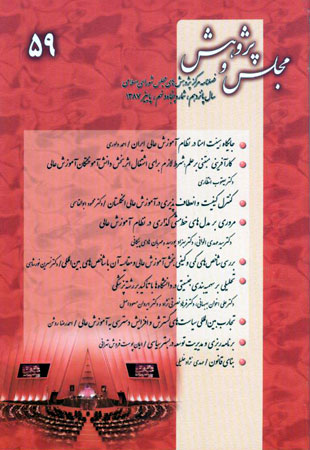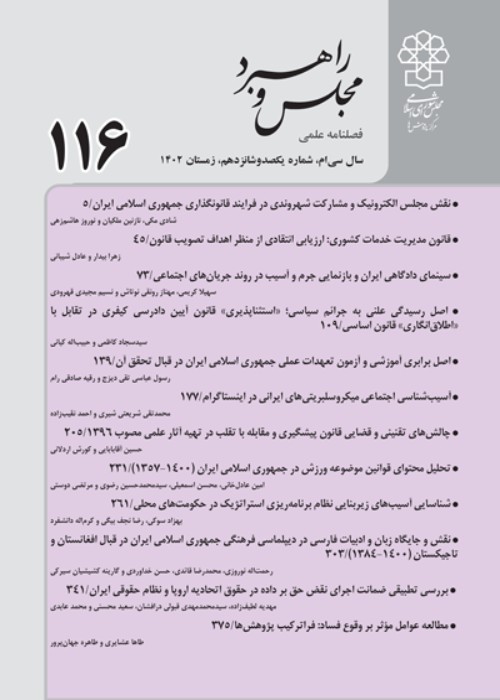فهرست مطالب

فصلنامه مجلس و راهبرد
پیاپی 59 (پاییز 1387)
- 284 صفحه، بهای روی جلد: 15,000ريال
- تاریخ انتشار: 1388/11/01
- تعداد عناوین: 10
-
صفحه 5
-
صفحه 221
-
Page 7Since the beginning of the establishment of the board of trustee of Iranian universities and higher education research institutes, their legal obligations have been challenged by regulatory-executive system.Therefore, the ratification of section a of article (49) of the 4th development plan Act that allows public academies and higher education research institutes and cultural schools to be administered only according to ad hoc organizational, financial, bureaucratic, and employment regulations approved by the relative board of trustees regardless of complying with bureaucratic public laws is known as a turning point of board of trustees obligations, however these legal obligations face with organizational and trans organizational challenges.In this regard the paper defines legal capacities of section a of article (49) of the 4th development plan Act by revising the background and it discusses the main problems face with its enforcement.Keywords: board of trustees_university_section a of article (49)_the 4th development plan act_higher education
-
Page 35According to the problem of Iranian university graduate's unemployment,the main objective of this paper is explaining "knowledge-based entrepreneurship" as an efficient way to improve university graduate's employment. In this regard, at first, knowledge-based entrepreneurship concept, kinds, process, and its effective factors are analyzed and second, knowledge-based entrepreneurship effect on university graduate's employment is discussed. Consequently, knowledge-based entrepreneurship should be expanded in universities and industry higher education system should be changed so that it can educate them as entrepreneur,creative, and learners as well.Keywords: higher education, employment, entrepreneurship, university, industry
-
Page 57High education as the highest education level is in charge of training,development and improvement of human resources experts. And according to this reason, it [HE] needs - more than the other levels - the quality endorsement and compliance with necessary standard andcriteria on the one hand and the measured and directed flexibility on the other hand. The nature, and the variable and vast constitution of the activities of high education makes the quality control act complicated and difficult. As a result of approach prevalence to the responsibility,quality endorsement has made the university performance changed in high education order, especially in the recent decades. Sometimes, the necessities and standards recommended by quality endorsement institutes have limited the arena of the flexibility of the universities. To this end, the experience of various countries concerning the common attention to the quality and flexibility are needed to be cared and studied precisely. In this regard, different countries have chosen different policies, among them, are the effective and forreaching ones prevalent in the university of Kingdom, which, with the emphasis on two diminutions of quality control and flexibility, are discussed and studied in this paper.Keywords: quality of high education, flexibility, university, high education of England, evaluation of the subjects, the skills of comprehensibility
-
Page 73The high education is one of the most valuable resource that a society uses for its progress and development. This section is also considered as one of the most effective means of each country for dealing with challenges of the present century. To achieve this significance, high education needs to under take proper policies and guide-lines on the ground of training and research in universities and the other high education institutes. Under taking such policies necessitate the high education order to have proper procedures and patterns of policy making at high decision making level, and the process of policy making is supposed to be such away that to take into accounts all scientific standards and all political social, economical and cultural situations of the society. So, it is necessary to submit a proper model of policy making process in the high education systems with a perspective of injury finding, to the current policy making process of the high education order of the country. Therefore, while describing and studying common models of this policy making of high education, this paper introduces the offered patterns towards policy making in the high education order of Iran.Keywords: policy making process, high education order, policy making model
-
Page 103The paper that is written based upon a library research method discusses the importance of Iran status at the era of producing technology and science that it has been recently considered. In this study, Iran status is compared with regional countries (such as Saudi Arabia, Jordan, Turkey, Pakistan, Algeria, Egypt, Tunisia, Kazakhstan, Libya, Oman, United Arab Emirates, Bahrain, and Syria) and some developed and developing countries (such as Germany, France, Japan,Canada, Norway, United States, England, Venezuela, Colombia, Ukraine, Argentina, Brazil, Indonesia, Malaysia, and Cuba) by using twenty technology achievement indicators (TAI). The data have been gathered by international databases such as UNESCO, World Bank,International Labor Organization (ILO), and UNDP to compare exactly as well as the data are based on the most recent databases have been available to all countries. According to the comparison, Iran has the lowest status of educational function indicators among all countries and it is ranked the lowest in seven indicators than regional countries too, it is ranked the lowest in technology and research indicators among all countries as well. But it is ranked the highest in research indicators than regional countries and it is ranked on average in technology indicators.Furthermore, Iran’s research indicators have rather high status than regional countries from 1990 to 2005.Keywords: higher education, technology, science, research, development indicator
-
Page 137One of the major problems that higher education has been recently faced is that female graduates have been recently increased than male graduates which it makes worry. The problem made authorities of higher education think of a remedy to remove the problem that following it, gender ratio has been proposed as a solution. There are pros and cons about the proposal.There fore first, the paper outlines it analytically and according to the main findings and second, it discusses whether the proposal should be carried out necessarily or not.Keywords: gender ratio, higher education, medicine, university
-
Page 161Universities are as a center of society rationality, transferor and productive of cultural and scientific wealth of societies, and keystone of creating human capital. By comparing significant difference between university tuition in developed countries and developing countries, we found that Higher education system development in countries are different in social and economic developments levels and it has direct relation with them. Particularly, developing countries need to educated individuals to develop as well as to adopt knowledge-based economy.In fact, higher education is not as a luxury item, but it is essential for the survival of countries.The paper reviews accessibility and expansion policies of higher education in some developed and developing countries and it discusses each of their problems and features. According to results of the study,expansion policies of higher education in developed countries are different from developing countries structurally. While the problem of developed countries is less demand, developing countries face to the problem of less supply of higher education.Keywords: the expansion of higher education, the accessibility of higher education, higher education policies in developed, developing countries
-
Page 189Economic planning can be defined as an organized, conscious, and continuous attempt to select the main economic variables (such as GDP, consumption, investment, saving, and etc) to achieve specific goals. Planning is a system that plans, performs, and controls development plans and it is produced by vertical cooperation (different generations of a society) and horizontal cooperation (different elements of a social system). Planning has two aspects: political and professional that neither it can be only produced on the basis of targeting by policymakers, nor can it be only created on the basis of rationality by different experts or specialists of all fields of planning. Authority, scientific consciousness,and convincing power are three main conditions of planners to harmonize social mobilization and national measurements and all of them depend on political high ranking official's consideration on proficiency and planning as far as possible.The ratification of plans is a part of executive and legislative powers tasks. First, how to settle the dispute that depends on law transparency of each of their duties and second, mutual understanding of expected performances of plans. Therefore, planning will be possible only by a bilaterally active participation process of policymakers and experts and consequently, they will reach a consensus. Continuous assessment of plans as well as establishing transparent and logical relations between experts (especially planners) and policymakers (particularly influentialofficials) are necessities of the codification of development plans. Of course, vital condition of continuous harmony between two groups shows that there are high professional and logical flexibility between them.Keywords: Planning system, plan, development, political management
-
Page 221In every legal system, law is the most important and original work of some social groups. Briefly, law is a norm that it is formed socially.H.A.L.Hart, an influential legal philosopher, suggests this view in his book, called "The concept of Law" as the most famous work that law is defined as a social rule called, "rule of recognition". It suggests the fact that social realities play fundamental role in making jurisprudence is a consensus of "Anglo-American" contemporary legal philosophers. That means not only Hart and other influential legal philosophers or advocates of legal positivism such as Joseph Raz and Jules Coleman agree with the view, but also Ronald Dworkin as the most famous for his critique of Hart's legal positivism accept it. Dworkin claims that there is inherent or necessary connection between law and morality within the framework of analytical philosophy. But what is law? Or must laws be rules? Now,there are two main answers for this question. In one hand, legal positivists generally refer to two groups of "authorities" or "jurisprudents" as a "recognitional community" from Hart's point of view: a distinction between the internal and external points of view of law and rules, and a distinction between the sociological and the legal perspectives of law.But popular constitutionalism believes that no law can be said to be efficacious unless followed by the majority of populace. They stress citizen's role as "recognitional community" in legal decision making.Therefore, there is a distinction between two theories: Harts and Dworkin. In order to remove the main problem "group-relative account of law" theory is provided. It means social norms such as eating or wearing are "group-relative". For example, a kind of wearing or eating can be known appropriately in a society while it can be known inappropriately in another society.Keywords: Rule of recognition, popular constitutionalism, recognitional community, social event, group, relative account of law, social reality


